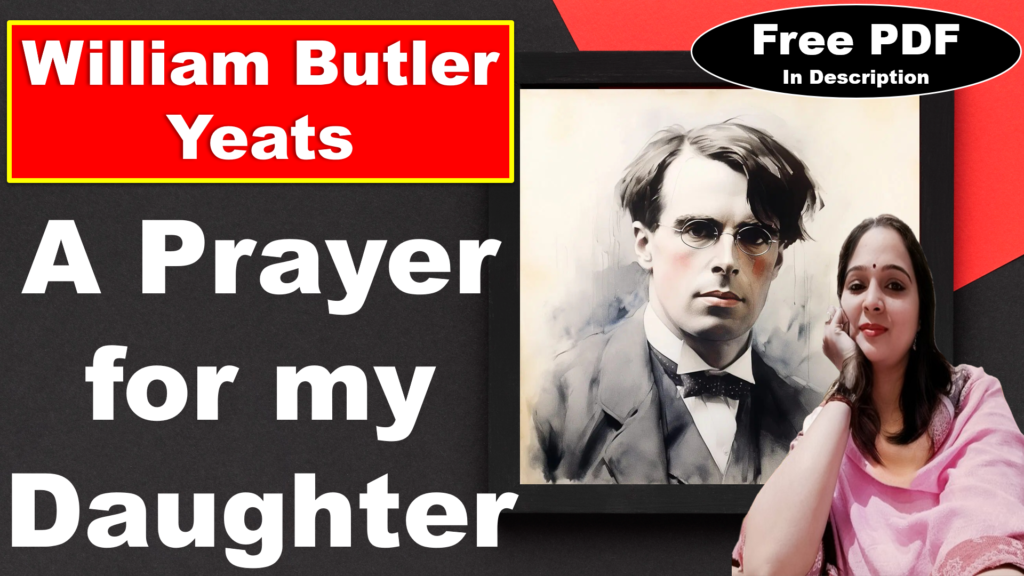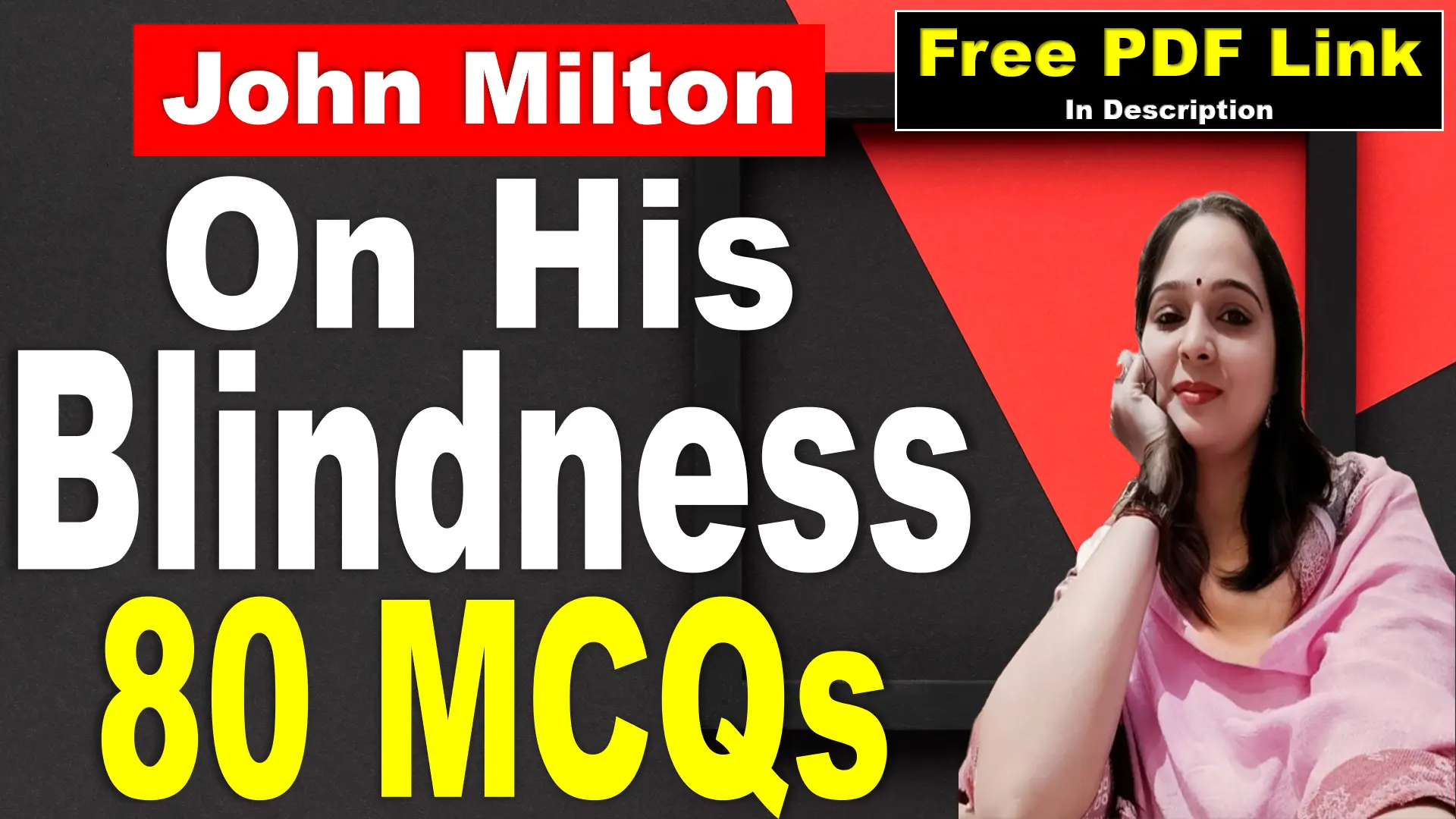
Essay Type Questions
1. Write the critical appreciation of the poem “A Prayer for My Daughter” by William Butler Yeats.
Introduction
“A Prayer for my Daughter” is a deeply moving and thought-provoking poem by William Butler Yeats, one of the most important figures of 20th-century literature. Written in 1919, two days after the birth of his daughter Anne, the poem captures Yeats’s hopes and fears for his newborn child. Set against the backdrop of a storm, the poem explores themes of parenthood, beauty, wisdom, and the tumultuous world that his daughter will grow up in.
Structure, Form, and Rhyme Scheme
The poem is written in the lyric form containing ten eight-line stanzas. Each stanza has eight lines written in iambic pentameter or iambic tetrameter, giving the poem a rhythmic quality that enhances its emotional depth. The poem follows a regular rhyme scheme of AABBCDDC, which adds to its musicality and helps to emphasize key ideas.
Theme
The central theme of the poem is a father’s profound desire for his daughter to grow with wisdom. Yeats expresses his hopes that his daughter will lead a life of humility and kindness, and that she will not be overly influenced by beauty. The poem also explores the theme of beauty and its potential dangers, as seen in the references to Helen of Troy. Through these themes, Yeats reflects on the challenges and joys of parenthood, and the hopes and fears that all parents have for their children.
Imagery
Yeats uses vivid imagery to convey his thoughts and emotions in the poem. The storm raging outside as his daughter sleeps peacefully is a powerful image that sets the tone for the poem. This contrast between the storm and the sleeping child symbolizes the tumultuous world that his daughter will grow up in, and the peace and innocence of childhood. The references to Helen of Troy and the great queen also create strong visual images, serving as warnings of the dangers of beauty and the chaos it can cause.
Poetic Devices
Yeats uses a variety of poetic devices to enhance the meaning and impact of the poem. Symbolism is used extensively, with the storm symbolizing the tumultuous world that his daughter will grow up in, and the references to ‘Helen’ and ‘that great Queen’ serving as warnings of the dangers of beauty. The use of iambic pentameter and tetrameter gives the poem a rhythmic quality, while the regular rhyme scheme helps to emphasize key ideas.
Conclusion
In conclusion, “A Prayer for my Daughter” is a rich, complex reflection on the joys and struggles of parenthood, the challenges of growing up in a tumultuous world, and the hopes and fears that all parents have for their children. Through its vivid imagery, thoughtful exploration of themes, and effective use of poetic devices, the poem captures the universal concerns of a parent for their child. It not only expresses the helplessness of Yeats as a father but all fathers who had to walk through this situation.
2. Write long note on Poetic devices used in Poem “A Prayer for My Daughter” by William Butler Yeats.
“A Prayer for My Daughter” by William Butler Yeats is a powerful and evocative poem that explores the poet’s hopes and fears for his daughter’s future. The poem is rich with poetic devices, which contribute to its emotional depth and complexity. Here, we delve into some of the most prominent poetic devices used in the poem:
1. Imagery:
Visual: The poem is filled with vivid visual imagery that allows the reader to visualize the concepts and emotions explored. The “thoroughfares” bustling with negativity, the “rich horn” symbolizing abundance, and the “spreading laurel tree” representing success and immortality are all examples of concrete details that create a strong visual impression.
Abstract: The poem also uses abstract imagery effectively to evoke deeper meanings and prompt reflection. Concepts like “innocence,” “beauty,” “arrogance,” and “ceremony” are used to explore complex themes without being overly specific, allowing the reader to interpret them in their own way.
2. Figurative Language:
Metaphors: The poem uses several powerful metaphors that enrich its meaning and create memorable images. Comparing “ceremony” to a “rich horn” and “custom” to a “spreading laurel tree” emphasizes the positive outcomes associated with tradition and stability. Additionally, metaphors like “wares are peddled” suggest that negativity is actively spread and sold in the outside world.
Rhetorical Questions: The speaker poses several rhetorical questions, such as “How but in custom and in ceremony are innocence and beauty born?” These questions invite the reader to consider the importance of tradition in nurturing these positive qualities and engage with the poem’s themes on a deeper level.
Personification: The poem uses personification to give human qualities to inanimate objects or abstract concepts. For example, “thoroughfares howl” and “bellows burst” suggest that negativity and anger are active forces in the world.
3. Sound Devices:
Assonance: The repetition of vowel sounds, such as in “thoroughfares” and “wares,” creates a sense of rhythm and musicality, adding to the poem’s emotional impact.
Enjambment: Lines often run over without a pause, forcing the reader to continue reading and creating a sense of flow and connection between the ideas.
Caesura: The use of pauses, such as the one after “innocence” in line 6, emphasizes the importance of certain words and phrases, adding weight to the speaker’s message.
4. Other Devices:
Conditional Clauses: The poem starts with a conditional clause, “And may her bridegroom bring her to a house,” setting the stage for the poem’s message and highlighting the dependence on external factors.
Descriptive Phrases: Phrases like “accustomed,” “ceremonious,” and “rich horn” provide details that paint a clear picture of the desired characteristics of the daughter’s future home and the qualities associated with tradition.
Symbolism: The poem uses symbols to represent complex ideas and emotions. The “thoroughfares” symbolize the outside world, potentially filled with negativity and danger. In contrast, the “rich horn” and “spreading laurel tree” symbolize the positive outcomes associated with tradition and custom.
Overall:
The masterful use of poetic devices in “A Prayer for My Daughter” elevates it from a simple poem to a complex and thought-provoking work of art. The vivid imagery, powerful metaphors, and other devices work together to create a rich and immersive experience for the reader. Through these devices, Yeats crafts a lasting testament to his love for his daughter and his hopes for her future, offering a timeless message about the importance of tradition, inner peace, and finding beauty in a challenging world.
3. Discuss the role of tradition and custom in “A Prayer for My Daughter” and how they are presented as both positive and negative forces.
Tradition and custom play a complex and multifaceted role in “A Prayer for My Daughter.” While Yeats initially presents them as positive forces that can nurture innocence and beauty, he also acknowledges their potential negative aspects.
Positive aspects:
Protection: Yeats believes that tradition and custom offer a safe haven for his daughter, protecting her from the negativity and chaos of the outside world.
Stability: The rituals and traditions provide a sense of order and stability, which Yeats believes is essential for a happy and fulfilling life.
Nurturing positive qualities: He believes that tradition and custom can help his daughter cultivate positive qualities like innocence, beauty, and inner peace.
Negative aspects:
Restriction: Yeats recognizes that tradition and custom can also be restrictive and limiting, potentially stifling individuality and preventing personal growth.
Exclusion: The emphasis on specific traditions can lead to exclusion and discrimination against those who fall outside their boundaries.
Blind adherence: Blind adherence to tradition can hinder critical thinking and prevent progress.
4. Explore the speaker’s anxieties and fears about the world his daughter will inherit, and analyze how these anxieties shape the poem’s tone and message.
The poem is filled with the speaker’s anxieties and fears about the world his daughter will face. He worries about the negativity, hatred, and arrogance that permeate society, as seen in lines like “For arrogance and hatred are the wares / Peddled in the thoroughfares.” He fears that these negative forces could corrupt his daughter and prevent her from experiencing true happiness and fulfillment.
These anxieties contribute to the poem’s somber and introspective tone. The speaker grapples with the uncertainties of the future and expresses his desire to protect his daughter from the harsh realities of the world. This is evident in the urgent pleas and protective language he uses throughout the poem.
Moreover, the speaker’s anxieties influence the poem’s message. He emphasizes the importance of shielding his daughter from the negativity of the outside world and nurturing her innocence and beauty within the confines of tradition and custom. He believes that this is the best way to ensure her future happiness and well-being.
While the poem is ultimately driven by hope and love for his daughter, it cannot escape the shadow of the speaker’s anxieties. This creates a complex and nuanced tone that resonates with readers who share similar concerns about the world they live in.
5. Discuss the poem’s portrayal of beauty and its connection to innocence and happiness.
The poem presents a multifaceted view of beauty, exploring its connection to both innocence and happiness. While the speaker clearly desires beauty for his daughter, he also expresses concerns about the potential downsides of excessive beauty. He warns against the dangers of vanity and superficiality, suggesting that these can lead to unhappiness and a shallow heart.
Instead, the poem emphasizes the connection between beauty and innocence. The speaker believes that true beauty arises from within, nurtured by purity of heart and a genuine connection to life. This kind of beauty is enduring and resilient, capable of withstanding the challenges of the world.
Happiness, in the poem’s view, is intimately linked to both beauty and innocence. The speaker believes that a simple life grounded in tradition and protected from negativity is the key to finding true happiness. He desires for his daughter to find contentment within herself, drawing upon her inner beauty and innocence rather than seeking external validation.
Through its exploration of beauty, innocence, and happiness, the poem offers a timeless message about the importance of inner peace and finding joy in simple things. It encourages readers to look beyond superficial beauty and strive for a deeper understanding of what truly matters in life.





